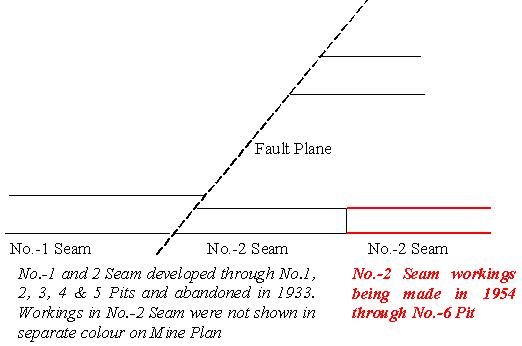You are here :
Home Newton Chikli Colliery on 10.12.1954
|
Last Updated:: 02/06/2015
Newton Chikli Colliery on 10.12.1954
Newton Chikli Colliery
| Date of the Accident |
- 10.12.1954 |
| Number of persons killed |
- 63 |
| Owner |
- Newton Chickly Collieries Ltd. |
| Place |
- Dist. Chhindwara (M.P.) |
Flooding of the mine was caused by inrush of water from old workings of the same mine. The parting between Top seam and Bottom seam was about 13 m and a fault of about the same throw had brought the two seams more or less in juxtaposition. Workings made in the Top seam were abandoned in 1933 and a huge quantity of water had accumulated in the abandoned workings between 1933 and 1954. The new workings in Bottom seam got connected with the old water-logged workings and water rushed in to flood the new workings. The old workings had not been shown correctly on the plan. The management was not aware that the new workings had approached so close to the abandoned workings and therefore no exploratory advance boreholes were being drilled in the new headings.

There were 112 persons inside the mine when it was inundated. 49 persons managed to effect their escape through the incline; the remaining 63 persons were entrapped and drowned.
This was the most serious disaster that had occurred due to wrong survey and improper study of the plans. The Court inquiring into this disaster made the following recommendations which were later incorporated in the regulations:-
- The original plan of workings of an abandoned mine should be preserved in the office of the mine and a certified true copy submitted to the RIM [CMR-61 (2),61(1),61(3)(a)]
- When the workings of a mine are within 60 m of old workings in any horizon, the CIM should be informed and an agreed scheme of approach should be evolved [CMR-127(3)]. The owners of adjoining mines shall be bound to disclose the plans of abandoned workings within a distance of 60 m [CMR-59(4)(b)].
- All statutory plans shall be serially numbered and a record thereof maintained in a register. Entries in the register shall be signed and dated by the surveyor and countersigned and dated by the manager. All field books and other records relating to the preparation of plans shall be carefully preserved [CMR-63].
- The current working plans of every mine should show the position of old goaves, within the leasehold and within 60 m of the boundary of the leasehold as also all drifts, staple pits and exploratory headings in the same seam or different seams [CMR-59(b)]. The position of all boreholes should be shown [59(1)(a)].
- Reduced levels of the floor in the galleries and at the faces of exploratory galleries, drifts and staple pits should be shown when the mine is abandoned. Drifts in stone and galleries in coal at different levels should be clearly indicated by different colours and with appropriate notings [CMR-59(3)].
- A detailed survey of all workings must be made in every district in which extraction or reduction of pillars is about to take place [CMR-100(1)].
- The throw of each fault (when proved) should be written [CMR- 59(b)(vi)]. Barriers of coal to be left for safety or support shall be clearly marked in green (CMR-58]. Underground working plan shall be kept up-to-date within 3 months (CMR-58(3)].
- A section through the strata above the working seam and one or more sections of the seam being worked together with the height of galleries at different places should be shown on the plan [CMR-59(b)(v)].
- The surveyor should specify the original plan or document from which the copy or tracing has been made [CMR-64(3)].
- Records of personal visits to underground workings by the manager, asstt. Manager, surveyor and other supervisory staff should be maintained. [CMR-41 (1) (b), and others]
- Each colliery should have a qualified surveyor. Engagement of the services of one surveyor by more than one colliery at the same time should be subject to the approval of the CIM [CMR-35].